
In the event, I was very glad of a day's travel from Vienna to Budapest, courtesy of Railjet, to give my little legs a rest.
Being on holiday with a partner, even someone you live with, can be difficult. Ross and I certainly do not spend as much time in each other's company when we are at home. It's a small testament that we have gotten through this holiday without any rows at all - minor niggles simply come with the territory; we bicker like any long-standing couple.
What my body was certainly not used to is pushing a wheelchair so often and in the heat. I had been very glad that Vienna is, by and large, a flat city - unlike Brussels or Nuremberg. Nevertheless, my little legs were telling me that they have been used more and more often than they are used to.
There was nothing special about the rail journey itself apart from the delay - we were something like 30 minutes later getting into Budapest and our taxi transfer had just about given up on us. We had passed many sodden fields and rivers with burst banks on our journey. This was another part of the same phenomenon - power lines brought down by recent storms.
In Budapest, we are staying in another Meridien hotel. It feels as though we have a suite. The whole floor plan is probably equal to the footprint of the main part of our house without the outrigger kitchen area.
There's


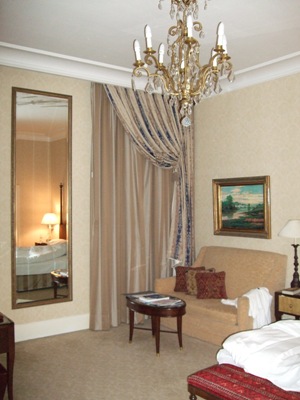
Come the evening we ate on a café terrace on the Belgrade Embankment in Pest overlooking the Danube as the sun set and turned the sky burnt red behind the Royal Palace and the Mátyás church on Buda's Castle Hill. I had a rich game goulash in red wine sauce with noodles and it was very good.
As we might have guessed from those water-logged fields that we saw getting here, the Danube is in flood at the present. About a fortnight ago, we have been told, there was extensive torrential rain which produced flash flooding in this area. That water has now drained into the Danube. Consequently the river is much higher than it should be at this time of the year and it has flooded the freeway and the tram tracks on either side of the river. The white building that you can see below is a sort of ticket office for the river cruises plus a tourism information kiosk. We used it as a measure of how far the clean up had progressed over the next three days.


 We walked up the embankment to the famous Chain Bridge built in the mid-19th century to an Englishman's design (William Tierney Clark) by a Scottish engineer (Adam Clark - the two were unrelated). The sky was reddening even further. We took a walk out a little way onto the bridge and admired both the lions and the amount of flotsam in the water.
We walked up the embankment to the famous Chain Bridge built in the mid-19th century to an Englishman's design (William Tierney Clark) by a Scottish engineer (Adam Clark - the two were unrelated). The sky was reddening even further. We took a walk out a little way onto the bridge and admired both the lions and the amount of flotsam in the water.


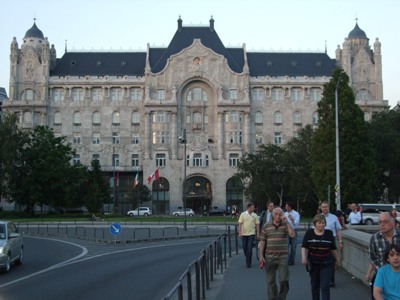 As we retraced out steps, now with the sun behind us, the light was catching the gold inlay on the building in front of us.
As we retraced out steps, now with the sun behind us, the light was catching the gold inlay on the building in front of us.
This turned out to be the Gresham Palace, now a hotel, across Roosevelt Square (one of the big mysteries is to why this square should be named after - presumably - an American President in 1946; maybe Yalta did not seem such a great betrayal then).
The Gresham itself is named after the UK Life Assurance Company. You may remember that this name also cropped up in Brussels. The company commissioned this building in 1907, presumably at the height of its commercial reach, and is Secessionist in style. We agreed to explore this further at some point.
As I said near the beginning of the holiday, Art Deco and its siblings Jugendstil and Secession have been a theme running through this holiday like the swifts that we have heard screaming in the air above us in every place we have visited.
Breakfast in the morning was the usual lavish affair that has become customary in these four star hotels. I did have difficulty in keeping a straight face, however. There are a number of reasonably good looking young men who are extremely attentive in the waiting department. They are also very keen to practice their English. However, to my ears, they sound like they have strolled off the set of the Hungarian/Czech-based porn company, Bel Ami.
![]() Ross and I are particularly taken with Tomás. I have noted a large firm rump; Ross has noted a prodigious forward appendage - each to his own.
Ross and I are particularly taken with Tomás. I have noted a large firm rump; Ross has noted a prodigious forward appendage - each to his own.
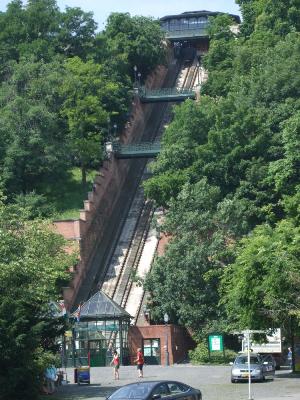 The following day we wanted to explore Castle Hill and so we crossed the Chain Bridge to use the funicular railway. Surprisingly, this contraption hardly gets a mention in our Guide Books. Maybe the authors have something against a mode of travel which looks like a beach hut ascending a precipice.
The following day we wanted to explore Castle Hill and so we crossed the Chain Bridge to use the funicular railway. Surprisingly, this contraption hardly gets a mention in our Guide Books. Maybe the authors have something against a mode of travel which looks like a beach hut ascending a precipice.
Notably also, Ross, as a wheelchair passenger, went free. And this was after I had bought four adult tickets. The ticket operator refunded the excess florints. Imagine that happening in the UK.
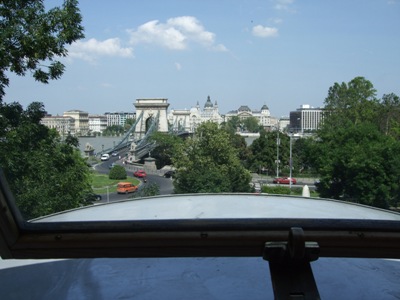
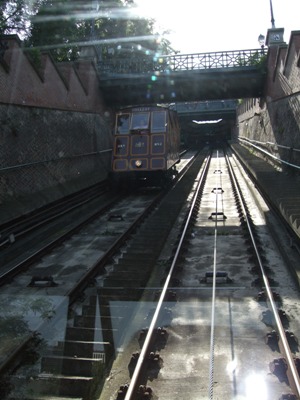
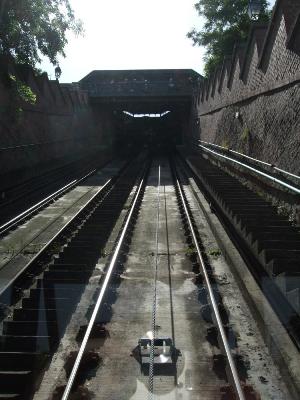

At the top, there was an amazing panorama of the city of Pest - we were, of course, in old Buda - Parliament Building to the left, Chain Bridge in the centre and central Pest (where we were staying) to the left along with the Elizabeth Bridge.



 We walked along to the Royal Palace and, frankly, they didn't stint themselves, those Habsburgs.
We walked along to the Royal Palace and, frankly, they didn't stint themselves, those Habsburgs.
To the right is the Mátyás fountain. This depicts the romantic and romanticised tale of King Mátyás Corvinus and his beloved Ilonka. He lived in the late 15th century; his highly embellished life is the subject of a 19th century ballad poem by Mihály Vörösmarty;
the statue was designed by Alajos Stróbl in 1904. What a wonderful thing it is to have a guide book which tells you educational stuff like this.
![]()
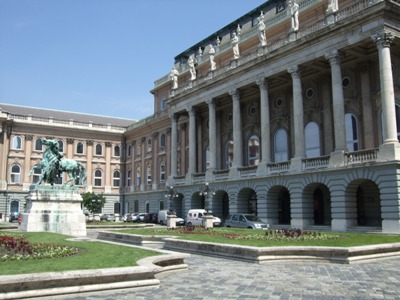 One of the main reasons why we up in this neck of the woods was to visit the Hungarian National Gallery. Like the Germanisches Nationalmuseum I visited in Nuremberg, the collection focusses on work produced in the country of origin. From the guide book we'd seen quite a lot of work which we liked produced by names which we'd never heard of.
One of the main reasons why we up in this neck of the woods was to visit the Hungarian National Gallery. Like the Germanisches Nationalmuseum I visited in Nuremberg, the collection focusses on work produced in the country of origin. From the guide book we'd seen quite a lot of work which we liked produced by names which we'd never heard of.
 However, we spent the first hour or so of our stay in the gothic and medieval collection looking at altar pieces. In Britain, we have gotten used to seeing work by Italian painters taken out of context - a Madonna here, a crucifixion there. What we don't see much of, because we destroyed our own and then, several centuries later, bought up chopped up portions of Italian ones, are complete altar pieces. Well, they had several rooms full in this place. The Great Throne Room alone held a dozen or so examples of work from the 15th and early 16th centuries. All in all, it was yet another superb encounter with the medieval which this holiday has thrown up for me.
However, we spent the first hour or so of our stay in the gothic and medieval collection looking at altar pieces. In Britain, we have gotten used to seeing work by Italian painters taken out of context - a Madonna here, a crucifixion there. What we don't see much of, because we destroyed our own and then, several centuries later, bought up chopped up portions of Italian ones, are complete altar pieces. Well, they had several rooms full in this place. The Great Throne Room alone held a dozen or so examples of work from the 15th and early 16th centuries. All in all, it was yet another superb encounter with the medieval which this holiday has thrown up for me.
![]()

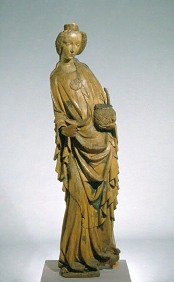
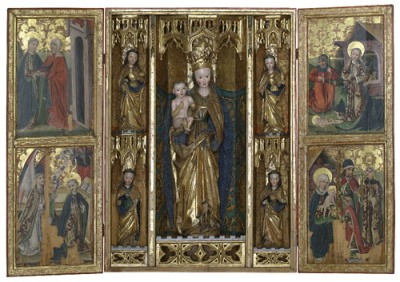
After a quick bite to eat with Ross's parents, Ross and I prepared to launch ourselves on the rest of the collection. Firstly, we took in a temporary of work by Fortunato Depero, another of the Italian Futurists/Divisionists who I was so knocked out by a few years ago. His work was good ![]() but was trumped by the accompanying exhibition of works produced by Hungarian artists at the same time; this was very good. I particularly liked the work of Hugó Scheiber.
but was trumped by the accompanying exhibition of works produced by Hungarian artists at the same time; this was very good. I particularly liked the work of Hugó Scheiber. ![]()
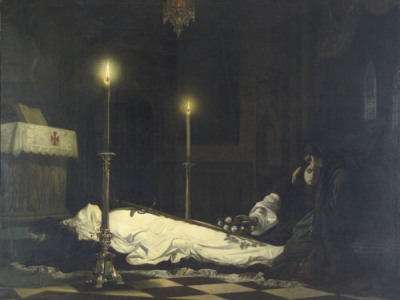 And, at this point, things went a bit pear shaped. I was deep into big historical paintings from the nineteenth as exemplified by The Mourning of László Hunyadi by Victor Madarász when staff started to make announcements about the gallery closing for the afternoon. They pointed out notices which, I am sure, were not in place when we first entered the museum and which announced that the closure would take place from 2pm for undisclosed technical reasons.
And, at this point, things went a bit pear shaped. I was deep into big historical paintings from the nineteenth as exemplified by The Mourning of László Hunyadi by Victor Madarász when staff started to make announcements about the gallery closing for the afternoon. They pointed out notices which, I am sure, were not in place when we first entered the museum and which announced that the closure would take place from 2pm for undisclosed technical reasons.
It was half past one so we decided to have a go at seeing as much as possible of the rest of the collection. I spent some time looking at some works by Károly Ferenczy which I thought were very good.
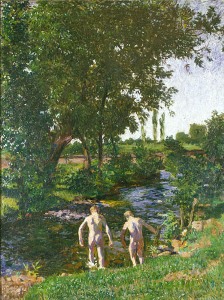
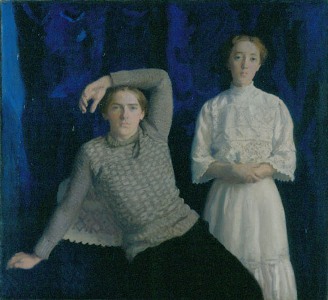
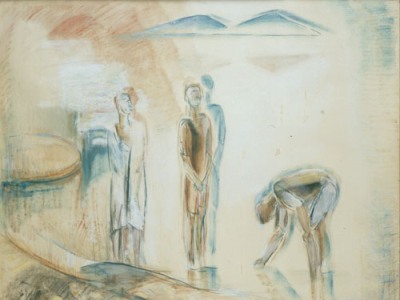 Ross preferred József Egry. He liked the more muted pallette at work.
Ross preferred József Egry. He liked the more muted pallette at work.
Even though there was still plenty of time to go, staff were busily closing rooms and generally making us unwelcome. We decided not to push things any further and left. It was the only unpleasant thing to happen to us during the whole of our stay in Budapest. And, as we agreed, seeing the rest of the collection gives us a positive reason to return some day.
 Making a virtue of necessity, we toiled along the Castle Hill in the full heat of the day (round about 36°C) and into the Old Town. The photograph opposite is of Lords' Street. It is a typical view of this quarter with its elegant two and three storey buildings. And I think that it was round about this point that my love affair with the architecture that Budapest has to offer began.
Making a virtue of necessity, we toiled along the Castle Hill in the full heat of the day (round about 36°C) and into the Old Town. The photograph opposite is of Lords' Street. It is a typical view of this quarter with its elegant two and three storey buildings. And I think that it was round about this point that my love affair with the architecture that Budapest has to offer began.
For example, below are two photographs of other buildings in this area. To the left is the State Archive of Historic Documents and to the right is the Mátyás Church. If you know the the Stephansdom in Vienna, then you'll know that it has a green and yellow tiled roof which has been spectacularly restored. If you only know Vienna, then you could be forgiven for thinking that this was wonderful, one-off example of medieval design. the two building below give the lie to that notion. And there were a number of other examples of this design style around the city.


It was late in the afternoon by the time we had descended the funicular railway and had crossed the Chain Bridge again. Ross went straight to bed. I took myself off to the Ambassador Terrace and had a couple of pints of Dreher - my local beer of choice. I read a little of my book and watched the world pass up and down the embankment and looked over at Castle Hill. As the afternoon turned to evening, I returned to my Rossi in the hotel. We lazed and showered and ate and showered and so the rest of the day passed most pleasantly.
 The following day we put the morning aside to walking through the town, following a couple of the routes suggested by our Dorling Kindersley book but knowing the series well enough now to know that straying off their preferred routes often brought its own pleasures.
The following day we put the morning aside to walking through the town, following a couple of the routes suggested by our Dorling Kindersley book but knowing the series well enough now to know that straying off their preferred routes often brought its own pleasures.
For example, the beautifully embellished building to the right gets no mention. I have no idea whether it is important or not. I do know that I liked what I saw. Similarly, I liked the building below on the left even though it does not get a mention and was iffy about the Klotild Palaces seen, on the right, which do merit comment.


 A little further down from the two buildings was the Liberty Bridge. Over the water from here, I would have got to the Gellért Baths or the Rác or Rudas Baths. It was one of my aims to visit one of those three but I didn't.
A little further down from the two buildings was the Liberty Bridge. Over the water from here, I would have got to the Gellért Baths or the Rác or Rudas Baths. It was one of my aims to visit one of those three but I didn't.
Again, it gives me another reason to return sometime in the future.
 Moving down to the waterfront, the Danube had now dropped to a level where the clean up operations could begin. You can see the thick slurry of silt that has been deposited all over the slip road.
Moving down to the waterfront, the Danube had now dropped to a level where the clean up operations could begin. You can see the thick slurry of silt that has been deposited all over the slip road.
When we had first arrived some 48 hours earlier, this road was simply not visible beneath the swirling waters.
We strolled on and, arriving back in our area of central Pest near Erzsébet Square, we decided to have coffee and a pastry at Gerbeaud Cukrászda on nearby Vörösmarty Square. I had some Esterházy cake and a coffee whilst Ross had a marzipan slice and coffee. They were both expensively delicious.
The sun beat down and the shadows were at their shortest. In the square a trio of nut brown elderly gentlemen wearing formal if faded suits played klezmer music with its vigorous rhythms and wailing clarinet. Young men who had been pedalling their bicycle rickshaws stripped off their teeshirts and soaked them in the fountain nearby and then washed the sweat off their naked torsos. A group of breakdancers practiced and exhibited some distance off. A solitary bird chirped persistently.
Both Rossi and I could easily get used to this al fresco café style living.
Fortified, we made our way to Roosevelt Square and the Chain Bridge. On the freeway, there we found more evidence of the clean up operation. Members of the fire brigade were pumping water out from two underpasses, one for the freeway and one for the tram line.
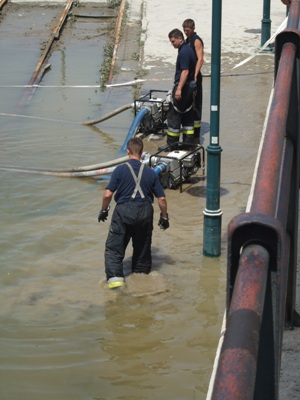
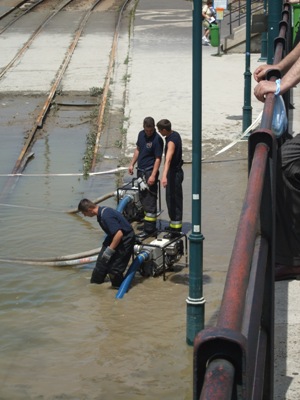
We decided to take a brief walk along the freeway since it was still restricted to traffic, though the occasional taxi did make a quick detour to avoid the traffic jams a few blocks inland. We came across the ticket office we had seen half-submerged two days' earlier.
On its side was a plaque giving the depth of classic floods over the past 150 years. From the photo above, which shows the water at about the level of the window sill, and, given the fact that the waters had already dropped somewhat by the time we arrived, we reckoned that the flood equalled that of the year 1954 - which, as it is my birth year, was obviously a very good year indeed.
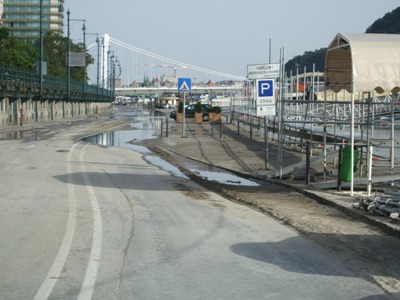
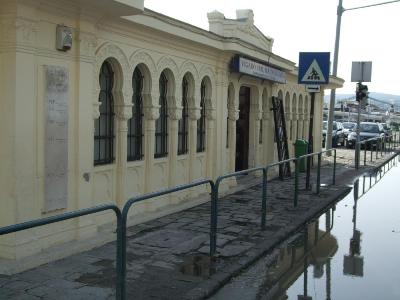
The waters had obviously done some considerable damage. We'd seen a whole set of decking torn apart up by the Chain Bridge. Goodness only know where the planters below had originally stood but they'd obviously been tossed about quite a bit. And, as you can see from the other photograph, detritus ranging from plastic bottles to great tree stumps had been washed downstream.
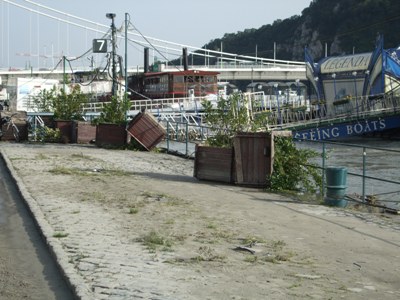

 We strolled back along the freeway to Roosevelt Square. We took a look inside the Gresham Palace, which was actually more impressive outside than in, and had a quick look at the Hungarian Academy of Science, which is just another of that unending stream of pleasantly designed and conceived buildings which populate the centre of Budapest.
We strolled back along the freeway to Roosevelt Square. We took a look inside the Gresham Palace, which was actually more impressive outside than in, and had a quick look at the Hungarian Academy of Science, which is just another of that unending stream of pleasantly designed and conceived buildings which populate the centre of Budapest.
 Our next port of call was St Stevens Basilica. We approached the great church along a strategically positioned pedestrian street, Zrinyi Street.
Our next port of call was St Stevens Basilica. We approached the great church along a strategically positioned pedestrian street, Zrinyi Street.
I was stopped by a trio of German tourists of a certain age. They wanted me to take a photograph of them and I duly obliged. They were delighted that I spoke a little German and we used a combination of German, English, French and mime to get our meanings across. It was a very European moment.
Our entry was somewhat impeded by the fact that the basilica is approached by a swathe of steps and the disabled chair lift was padlocked at the top and no-one in the building had the key. The solution was that two men assisted by my good self bodily lifted him in his chair up the steps. In case you're wondering, Ross left the building by shimmying down the steps on his bottom whilst I bumped his chair down on its own.

Once we got inside, we encountered a notice requesting silence because there was a service in progress. Visitors were moving around quite quietly and so we did likewise.
There was a sudden blast from the organ followed by the same note an octave above. Without a pause, a man intoned something. He was answered by a response from a second voice. Immediately, the organ played a bass note, a tone down from the first, followed again by the same note an octave above. Once again, two voices called out - an acclamation and a response. Same in the organ, a further tone down. Again the voices. Again the organ. Again the voices. And then suddenly, out of nowhere, an almost baroque-like flourish from the organ. A pause. The first voice called out once more - the second responded. I was enraptured. This seemed direct, powerful, quite an avante garde sort of worship - unlike anything that I might have expected in an Orthodox basilica.
There was more calling and responding from the two voices and more plain striking octave notes in the air.
And then I twigged. They were tuning the organ.
I felt such a fool.
As for the basilica itself, it is a riot of marble and gold. Not surprisingly, since it is a magnificently imposing building, the Guide Book has quite a bit to say about the structure and its contents.


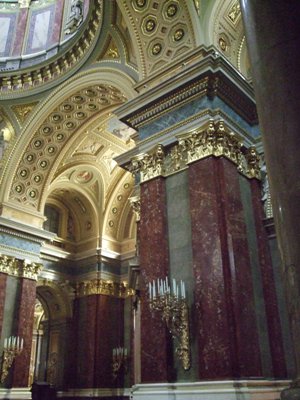

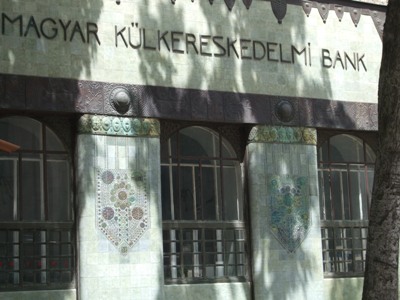 The Guide Book doesn't mention this piece of building design at all. In fact, if you keep your eyes alert, there is an enormous amount of fabulous design work on some of the most unexpected buildings.
The Guide Book doesn't mention this piece of building design at all. In fact, if you keep your eyes alert, there is an enormous amount of fabulous design work on some of the most unexpected buildings.
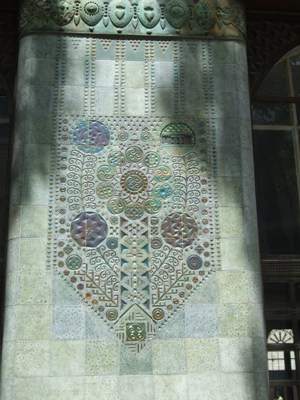
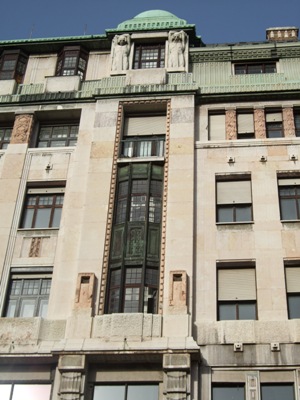
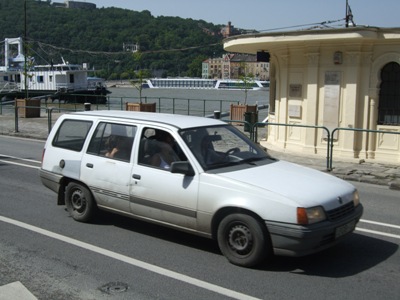 Come the Saturday morning, after we had had breakfast, we had a look down on the waterfront.
Come the Saturday morning, after we had had breakfast, we had a look down on the waterfront.
Apart from the fact that the river was obviously running a little high, you could hardly tell that there had been any flooding at all. There must have been teams working through the night to clear away debris and silt.
And the freeway was at last open and cars were passing by the ticket office which had been half-submerged some three days before.
 Ross went off the have a small trundle on his own. I took the Metro three stops from Vörösmarty Square to the Opera House. Here the Guide Book was out of date. The carriages were not the promised veteran wooden vintage models but a more modern design like a Tonka Truck. And to be honest, the design of the stations wasn't quite as interesting as I had hoped for.
Ross went off the have a small trundle on his own. I took the Metro three stops from Vörösmarty Square to the Opera House. Here the Guide Book was out of date. The carriages were not the promised veteran wooden vintage models but a more modern design like a Tonka Truck. And to be honest, the design of the stations wasn't quite as interesting as I had hoped for.
Nevertheless, I was briskly whisked those few stops out to where the Budapest Opera House lay. It was built in the late 19th century to rival Paris and Vienna. It clearly looks as though they achieved some of that.
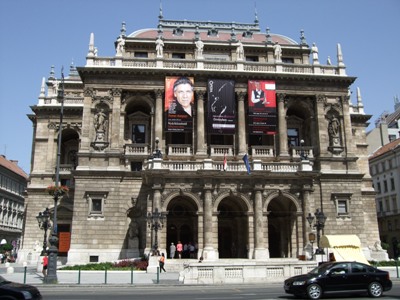

Really, many of these photographs could have been taken inside the basilica rather than the Opera House.
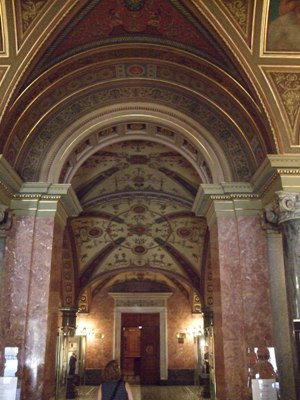
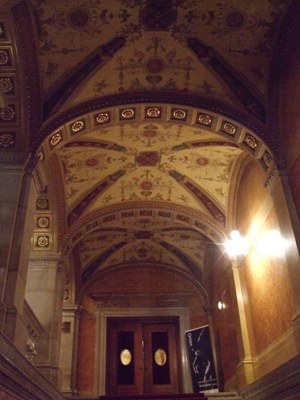
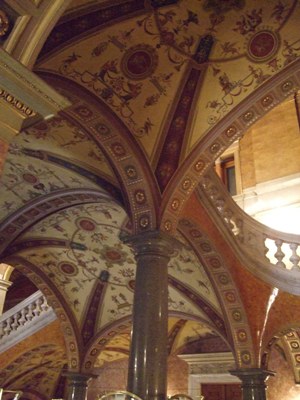
I lingered a little while but knew that I had to get back to the hotel to meet up with Ross and pack.
Our holiday was about to come to an end. A terrace meal near the basilica and that was it.
Our final taxi transfer arrived and it was time to begin the great trek home.